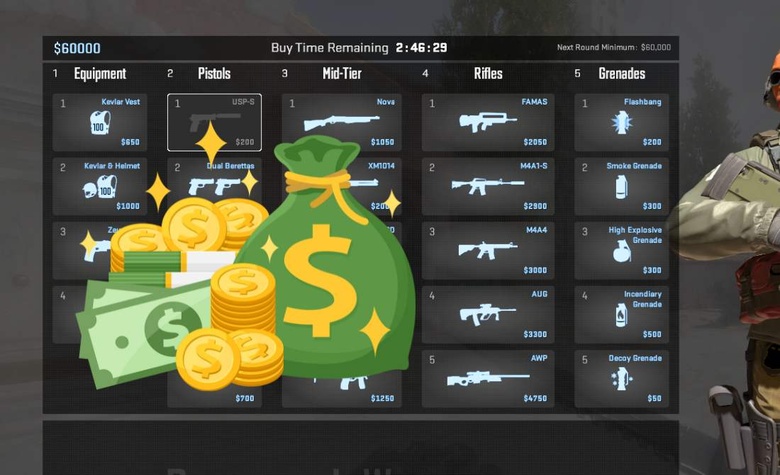The State of CS2's Economy

The Counter-Strike series has long been a staple and a significant shareholder in competitive esports, and since Global Offensive, a key component of the game became its intricate skin economy which still holds afloat.
The skin market operates as a separate yet interconnected and dependent financial ecosystem.
With the transition from Counter-Strike: Global Offensive (CS: GO) to Counter-Strike 2 (CS2), the game's skin market underwent some notable shifts, impacting both the prices of skins and the market as a whole.
The Skin Market Transition
The shift to CS2 was eagerly awaited by players and collectors, even though some were skeptical of it.
However, the upgraded graphics and engine sparked interest in how existing skins would appear in the new game. This anticipation drove a surge in skin demand in the months leading up to CS2's release. Many believed that improved visuals would boost their collections' value, prompting them to stock up on items. Yet, CS2's actual release led to a market correction.
Many skins saw a price drop, with some decreasing by 15-30% within the first 90 days. This downturn affected numerous skins, from high-tier items such as the AWP Dragon Lore to mid- and lower-tier ones. The reasons for this include:
- Initial Hype Overcorrection: Pre-release hype likely inflated prices and required adjustment post-launch.
- Uncertainty About Long-Term Support: Some investors hesitated to retain skins due to doubts about Valve's plans for the game's future and possible skin system changes.
- Market Saturation: The increased skin supply, due to players selling collections to secure profits, may have surpassed demand, lowering prices.
Despite the initial dip, the market has shown signs of stabilizing. Counter-Strike's popularity and players' strong emotional ties to their skins imply that the market would very likely rebound properly.
Although a virtual economy, many have compared CS’s skin trading with games of odds and chances, like casinos, where many expect to profit by joining in at the right time and cashing out big. But for those who still prefer the traditional one, there’s a variety of online casinos you can choose from, all offering unique bonuses.
Sought-After Skins
As you know, rarity, aesthetics, and historical significance drive the CS2 skin market. Some skins have become iconic within the community and command high prices on Steam and third-party sites. The ones that remain popular to this day and that weren’t affected by the transition for CS2 are:
- AWP Dragon Lore: This sniper rifle skin is famous for its intricate design and rarity. Factory New versions can sell for tens of thousands of dollars.
- Butterfly Knife Marble Fade: These knives are coveted for their animation, and the colourful Marble Fade variant increases their value.
- AK-47 Case Hardened (Blue Gem): Known for valuable patterns, the "Blue Gem" pattern, with a high percentage of blue, commands a premium price.
While these skins remain desirable, newer additions from recent cases have gained prominence and significant value:
- AK-47 | Gold Arabesque: Offers a luxurious design and fetches prices similar to older high-tier skins due to its rarity and striking look.
- AWP | Chrome Cannon: Noted for its sleek design and popularity among top players.
- M4A1-S | Welcome to the Jungle: Sought after for its vibrant colors and jungle theme.
The transition to CS2 impacted the case economy, very closely tied to the skins directly. Existing cases saw varied price movements, influenced by factors such as the rarity of the skins contained within and the overall market demand, some of which are due to trade-up contracts that require specific skins.
Cases containing highly sought-after skins, particularly those that looked impressive with CS2's updated graphics, often gained value, like the Operation Phoenix Weapon Case, containing iconic skins like the AK-47 Redline and AWP Asiimov.
Meanwhile, certain glove cases also surged in both popularity and pricing, as well as some of the first series cases like Bravo Case, which to this day still holds a value of around $60.
External Factors
Several external factors have influenced the CS2 skin market, besides the transition itself:
- Steam’s Availability in China: Steam's expansion into China widened the player base, increasing demand for skins and driving prices up, especially for the first released series.
- Valve's Decisionmaking: Valve's actions regarding new case releases, skin rarity, and game economy changes can greatly impact the market. New skin collections can dilute the market, lowering old skin prices, and cases have been added more frequently since the first drops.
Valve's Revenue
It is no secret that a major part of Valve’s revenue comes from well-established game economies, like the one around Counter-Strike, Team Fortress 2 and DoTA 2. The income channels coming from these giants are these:
- Steam Marketplace Fees: A fee is charged for each transaction.
- Case Keys: Players buy keys to open cases, providing revenue for Valve.
- Direct Skin Sales: Occasionally, Valve sells skins directly through the Steam Store.
Determining whether Valve profited more post-CS2 transition is challenging due to a lack of public financial data. However, player activity surged and skin trading continued, suggesting financial benefits for Valve. The game's enduring popularity and appealing skin market continue to generate significant revenue.
Conclusion
In conclusion, the CS2 skin market's complexity stems from various factors like player demand and skin rarity. Though CS2's transition caused initial market fluctuations, Counter-Strike's popularity and its dedicated community suggest the skin market will thrive in the years to come.